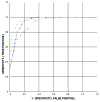Combination of quantitative capnometry, N-terminal pro-brain natriuretic peptide, and clinical assessment in differentiating acute heart failure from pulmonary disease as cause of acute dyspnea in pre-hospital emergency setting: study of diagnostic accuracy
- PMID: 19399946
- PMCID: PMC2681050
- DOI: 10.3325/cmj.2009.50.133
Combination of quantitative capnometry, N-terminal pro-brain natriuretic peptide, and clinical assessment in differentiating acute heart failure from pulmonary disease as cause of acute dyspnea in pre-hospital emergency setting: study of diagnostic accuracy
Abstract
Aim: To determine the diagnostic accuracy of the combination of quantitative capnometry (QC), N-terminal pro-brain natriuretic peptide (NT-proBNP), and clinical assessment in differentiating heart failure (HF)-related acute dyspnea from pulmonary-related acute dyspnea in a pre-hospital setting.
Methods: This prospective study was performed in the Center for Emergency Medicine Maribor, Slovenia, January 2005-June 2007. Two groups of patients with acute dyspnea apnea were compared: HF-related acute dyspnea group (n = 238) vs pulmonary-related acute dyspnea (asthma/COPD) group (n = 203). The primary outcome was the comparison of combination of QC, NT-proBNP, and clinical assessment vs NT-proBNP alone or NT-proBNP in combination with clinical assessment, in differentiating HF-related acute dyspnea from pulmonary-related acute dyspnea (asthma/COPD) in pre-hospital emergency setting, using the area under the receiver operating characteristic curve (AUROC). The secondary outcomes end points were identification of independent predictors for final diagnosis of acute dyspnea (caused by acute HF or pulmonary diseases), and determination of NT-proBNP levels, as well as capnometry, in the subgroup of patients with a previous history of HF and in the subgroup of patients with a previous history of pulmonary disease.
Results: In differentiating between cardiac and respiratory causes of acute dyspnea in pre-hospital emergency setting, NT-proBNP in combination with PetCO2 and clinical assessment (AUROC, 0.97; 95% confidence interval [CI], 0.90-0.99) was superior to combination of NT-proBNP and clinical assessment (AUROC, 0.94; 95% CI, 0.88-0.96; P = 0.006) or NT-proBNP alone (AUROC, 0.90; 95% CI, 0.85-0.94; P = 0.005). The values of NT-proBNP> or = 2000 pg/mL and PetCO2 < or = 4 kPa were strong independent predictors for acute HF. In the group of acute HF dyspneic patients, subgroup of patients with previous COPD/asthma had significantly higher PetCO2 (3.8 +/- 1.2 vs 5.8 +/- 1.3 kPa, P = 0.009). In the group of COPD/asthma dyspneic patients, NT-proBNP was significantly higher in the subgroup of patients with previous HF (1453.3 +/- 552.3 vs 741.5 +/- 435.5 pg/mL, P = 0.010).
Conclusion: In differentiating between cardiac and respiratory causes of acute dyspnea in pre-hospital emergency setting, NT-proBNP in combination with capnometry and clinical assessment was superior to NT-proBNP alone or NT-proBNP in combination with clinical assessment.
Trial registration: ClinicalTrials.gov NCT00878475.
Figures


References
-
- Remes J, Miettinen H, Reunanen A, Pyorala K. Validity of clinical diagnosis of heart failure in primary health care. Eur Heart J. 1991;12:315–21. - PubMed
Publication types
MeSH terms
Substances
Associated data
LinkOut - more resources
Full Text Sources
Medical
Research Materials
Miscellaneous

